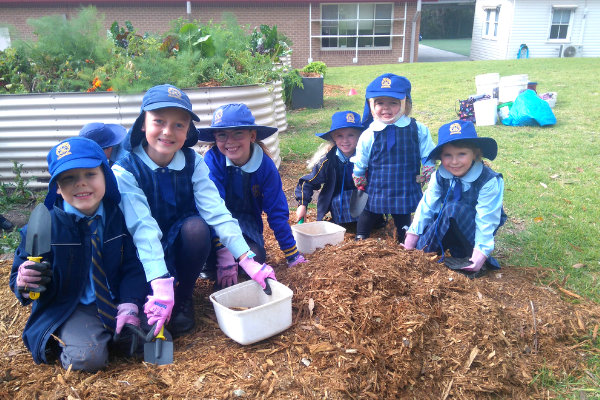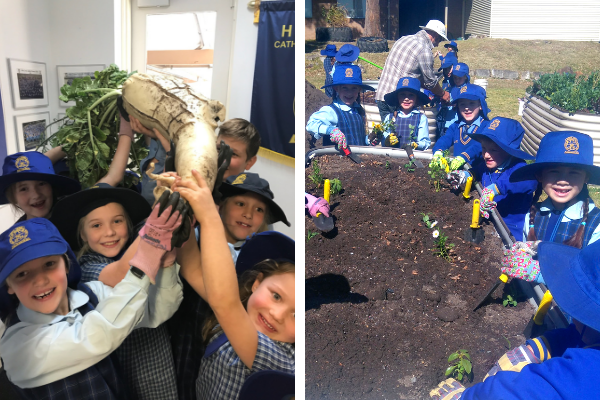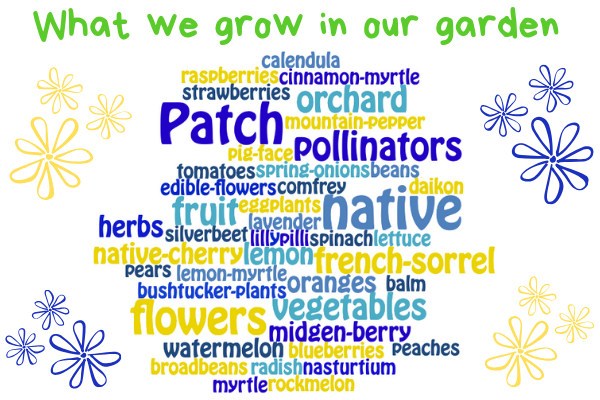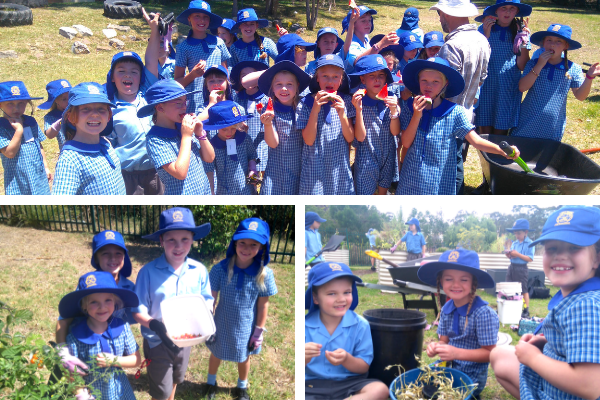Holy Cross gardens grow student learning
 There’s a lot more to the gardening club at Holy Cross than the beautiful gardens they’ve planted and nurtured – it’s a welcoming environment where friendships blossom and students are supported to grow; where the seeds of stewardship are sewn through many aspects of school life, and learning from nature and getting your hands dirty is valued like study from books.
There’s a lot more to the gardening club at Holy Cross than the beautiful gardens they’ve planted and nurtured – it’s a welcoming environment where friendships blossom and students are supported to grow; where the seeds of stewardship are sewn through many aspects of school life, and learning from nature and getting your hands dirty is valued like study from books.
Our school has achieved an impressive horticultural setup: a vegetable garden known as ‘The Patch’, an orchard, their Yalunga Garden (a peaceful native garden space) and their latest venture – bush tucker plants now also growing in The Patch.
The garden project was started after a gumtree fell on the school’s original, smaller vegetable patch a few years ago. We successfully applied for a NSW Government Eco Schools Grant in 2016, and the students decided to use the funds to create a garden the whole school could benefit from – installing 12 raised garden beds, an orchard and the food gardens that they enjoy today.
Holy Cross School Support Officer and gardening club co-ordinator, Sue Murray, said she runs weekly lunchtime sessions around maintaining and growing the gardens, where more than a full class of students ranging from Kindergarten to Year 6 will turn up to get involved.
“The students choose to give up their lunchtimes on a volunteer basis, and we often will have anywhere between 20 and 40 students. Sustainability, teamwork and friendship are the focuses of the club – everyone is welcomed and treated with respect, and we enjoy lots of learning and laughs along the way!” — Sue Murray, Holy Cross gardening club coordinator

“Everything we do is based on permaculture principles and practices,” Ms Murray explained. “We use and model a ‘seed to seed’ philosophy, which the students have really embraced. The giant daikon radish you see [pictured above] was a result of the students practicing permaculture principles and letting it grow to its fullest. They were keen to see just how big those radishes could get and were very excited at their success!”
Currently, the club is growing a myriad of fruits, vegetables, herbs, flowers and other plants:
- broad beans, lettuce, tomatoes, comfrey, french sorrel (a school favourite!), spring onions, watermelon, rockmelon, silverbeet, spinach, broad beans, daikon radish, lemon balm, strawberries, raspberries, blueberries, eggplants (and flowers throughout to attract the pollinators) in The Patch;
- pears, oranges, peaches in the orchard;
- edible flowers such as lavender, calendula, nasturtium; and
- bush tucker plants including lemon myrtle, cinnamon myrtle, midgen berry, lilly pilli, mountain pepper, native cherry and pig face.

Ms Murray works with local ecologist from Eco Logical Australia, Dr Rod Armistead, one day a week at the school to coordinate and run an eco-program for the children. This has been made possible for over five years now with funding provided by the local Peabody Energy mine.
“Rod and I are very passionate about our purpose within the school. We see ourselves in a 'consultative' type of role and encourage our students to make decisions on what they would like to do with the gardens. So they’re constantly evolving based on decisions made by the gardening club members,” she said.
“We offer activities including planting seasonal seeds, preparing garden beds with compost and mulching, and collecting seed to be used the following season. The children enjoy propagating native plants in particular, and they love harvesting and sampling the produce. We are now in a position to be able to do this each week. When there is enough, the club members visit chosen classrooms to share the produce with other students, too” — Sue Murray, Holy Cross gardening club coordinator
The funding also allows Dr Armistead and Ms Murray to provide curriculum-based sessions to all classes in the school, each comprising both a discussion/theory element and a practical, hands-on component.
“This term we are working with Stage 3 around their Science and Technology unit 'Adapt To Survive'. We introduce key terminology like 'structural' and 'behavioural' adaptations and then engage in practical tasks utilising both the classroom and outdoors to enhance the students’ learning experience.
“We’ve had students dig up and look at grasses and weeds in our school gardens like turkey rhubarb, then investigate what adaptations they’ve made to survive. Students have also identified local native fauna that can be found in the Helensburgh area and researched their specific adaptations.”
On the students’ insistence, the curriculum-based learning also includes a ‘taste and sniff’ activity – a much-loved part of the sessions since the very first classroom lesson, that has now become synonymous with the gardening club and its offerings.
“They’re very popular, our ‘taste and sniff’ activities! The students are offered two seasonal fruits, vegetables or herbs to taste and smell, and they decide what they like best. Our goal is to introduce fresh produce that students may not have tried before – like the french sorrel, which is now so popular amongst Holy Cross families, that the local nursery often sells out of it!” Ms Murray laughed.
What the students said:
"I love being in the gardening club and working as a team," said Kai, Year 4.
"Gardening club is so much fun. I love looking after the gardens," classmate, Charlotte, said.
"It's the best and I just love digging in the mulch," Jake from Year 1 beamed.
"You get to explore creatures and plants in the garden, and we get to eat what we grow!" said Alicia, Year 5.
"I love being close to nature and we have so much fun in the gardening club," fellow Year 5 student, Hayley, affirmed.

The gardening club also takes on other activities, including organising events and awareness on environment days throughout the year; sharing the latest produce from the garden with the broader school community; setting up experiment spaces for curriculum-based sessions; and making table centrepieces for Eco Logical's annual conference – a trademark addition to the occasion that has become quite popular with conference attendees, who like to keep the creations to take home.
“If the weather doesn't allow us outside, we do research projects based on the garden or topics such as Australian native flora. The students will work together in small groups to find out information about their topic and then share with the rest of the group, potentially informing our next project or work with the gardens. There’s always plenty to do,” Ms Murray said.
“For those students interested in furthering their gardening capabilities, we also create succulent ‘gardens in bowls’ with excess produce from The Patch, for the students to take home and nurture as their very own garden. Our club members get a real sense of pride taking theirs around to the teachers and leadership team to show how it is growing.
“It is definitely a dynamic and enthusiastic group. We have a lot of fun and the gardens are seeing the success of the children’s commitment and hard work.
“We are all about caring for each other in amongst caring for our common home, and importantly, learning about and promoting sustainability and stewardship of the school environment – a wonderful combination for our students and our school” — Sue Murray, Holy Cross gardening club coordinator
IN THE MEDIA
Illawarra Mercury, 13 June – Helensburgh school garden boosted by Peabody fund
WIN News Illawarra, 13 June – See Holy Cross Helensburgh's fantastic garden setup
